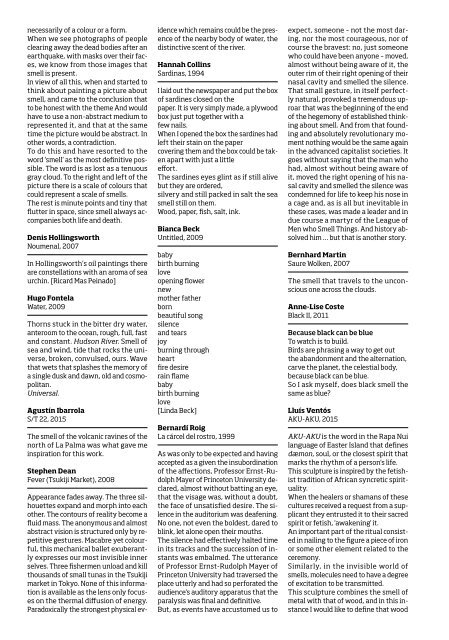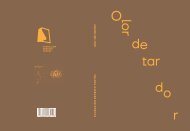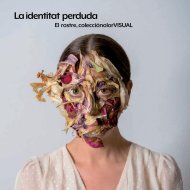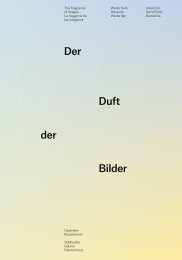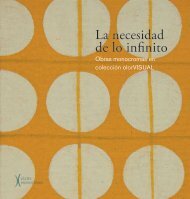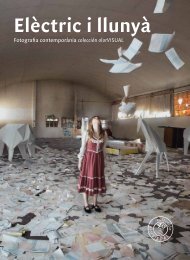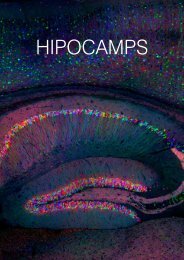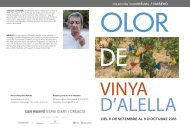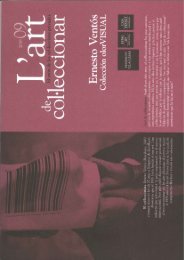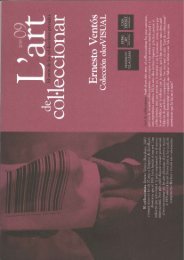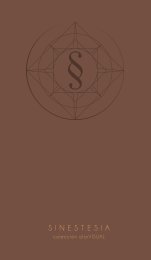Create successful ePaper yourself
Turn your PDF publications into a flip-book with our unique Google optimized e-Paper software.
necessarily of a colour or a form.<br />
When we see photographs of people<br />
clearing away the <strong>de</strong>ad bodies after an<br />
earthquake, with masks over their faces,<br />
we know from those images that<br />
smell is present.<br />
In view of all this, when and started to<br />
think about painting a picture about<br />
smell, and came to the conclusion that<br />
to be honest with the theme And would<br />
have to use a non-abstract medium to<br />
represented it, and that at the same<br />
time the picture would be abstract. In<br />
other words, a contradiction.<br />
To do this and have resorted to the<br />
word ‘smell’ as the most <strong>de</strong>finitive possible.<br />
The word is as lost as a tenuous<br />
gray cloud. To the right and left of the<br />
picture there is a scale of colours that<br />
could represent a scale of smells.<br />
The rest is minute points and tiny that<br />
flutter in space, since smell always accompanies<br />
both life and <strong>de</strong>ath.<br />
Denis Hollingsworth<br />
Noumenal, 2007<br />
In Hollingsworth’s oil paintings there<br />
are constellations with an aroma of sea<br />
urchin. [Ricard Mas Peinado]<br />
Hugo Fontela<br />
Water, 2009<br />
Thorns stuck in the bitter dry water,<br />
anteroom to the ocean, rough, full, fast<br />
and constant. Hudson River. Smell of<br />
sea and wind, ti<strong>de</strong> that rocks the universe,<br />
broken, convulsed, ours. Wave<br />
that wets that splashes the memory of<br />
a single dusk and dawn, old and cosmopolitan.<br />
Universal.<br />
Agustín Ibarrola<br />
S/T 22, 2015<br />
The smell of the volcanic ravines of the<br />
north of La Palma was what gave me<br />
inspiration for this work.<br />
Stephen Dean<br />
Fever (Tsukiji Market), 2008<br />
Appearance fa<strong>de</strong>s away. The three silhouettes<br />
expand and morph into each<br />
other. The contours of reality become a<br />
fluid mass. The anonymous and almost<br />
abstract vision is structured only by repetitive<br />
gestures. Macabre yet colourful,<br />
this mechanical ballet exuberantly<br />
expresses our most invisible inner<br />
selves. Three fishermen unload and kill<br />
thousands of small tunas in the Tsukiji<br />
market in Tokyo. None of this information<br />
is available as the lens only focuses<br />
on the thermal diffusion of energy.<br />
Paradoxically the strongest physical evi<strong>de</strong>nce<br />
which remains could be the presence<br />
of the nearby body of water, the<br />
distinctive scent of the river.<br />
Hannah Collins<br />
Sardinas, 1994<br />
I laid out the newspaper and put the box<br />
of sardines closed on the<br />
paper. It is very simply ma<strong>de</strong>, a plywood<br />
box just put together with a<br />
few nails.<br />
When I opened the box the sardines had<br />
left their stain on the paper<br />
covering them and the box could be taken<br />
apart with just a little<br />
effort.<br />
The sardines eyes glint as if still alive<br />
but they are or<strong>de</strong>red,<br />
silvery and still packed in salt the sea<br />
smell still on them.<br />
Wood, paper, fish, salt, ink.<br />
Bianca Beck<br />
Untitled, 2009<br />
baby<br />
birth burning<br />
love<br />
opening flower<br />
new<br />
mother father<br />
born<br />
beautiful song<br />
silence<br />
and tears<br />
joy<br />
burning through<br />
heart<br />
fire <strong>de</strong>sire<br />
rain flame<br />
baby<br />
birth burning<br />
love<br />
[Linda Beck]<br />
Bernardí Roig<br />
La cárcel <strong>de</strong>l rostro, 1999<br />
As was only to be expected and having<br />
accepted as a given the insubordination<br />
of the affections, Professor Ernst-Rudolph<br />
Mayer of Princeton University <strong>de</strong>clared,<br />
almost without batting an eye,<br />
that the visage was, without a doubt,<br />
the face of unsatisfied <strong>de</strong>sire. The silence<br />
in the auditorium was <strong>de</strong>afening.<br />
No one, not even the bol<strong>de</strong>st, dared to<br />
blink, let alone open their mouths.<br />
The silence had effectively halted time<br />
in its tracks and the succession of instants<br />
was embalmed. The utterance<br />
of Professor Ernst-Rudolph Mayer of<br />
Princeton University had traversed the<br />
place utterly and had so perforated the<br />
audience's auditory apparatus that the<br />
paralysis was final and <strong>de</strong>finitive.<br />
But, as events have accustomed us to<br />
expect, someone – not the most daring,<br />
nor the most courageous, nor of<br />
course the bravest: no, just someone<br />
who could have been anyone – moved,<br />
almost without being aware of it, the<br />
outer rim of their right opening of their<br />
nasal cavity and smelled the silence.<br />
That small gesture, in itself perfectly<br />
natural, provoked a tremendous uproar<br />
that was the beginning of the end<br />
of the hegemony of established thinking<br />
about smell. And from that founding<br />
and absolutely revolutionary moment<br />
nothing would be the same again<br />
in the advanced capitalist societies. It<br />
goes without saying that the man who<br />
had, almost without being aware of<br />
it, moved the right opening of his nasal<br />
cavity and smelled the silence was<br />
con<strong>de</strong>mned for life to keep his nose in<br />
a cage and, as is all but inevitable in<br />
these cases, was ma<strong>de</strong> a lea<strong>de</strong>r and in<br />
due course a martyr of the League of<br />
Men who Smell Things. And history absolved<br />
him … but that is another story.<br />
Bernhard Martin<br />
Saure Wolken, 2007<br />
The smell that travels to the unconscious<br />
one across the clouds.<br />
Anne-Lise Coste<br />
Black II, 2011<br />
Because black can be blue<br />
To watch is to build.<br />
Birds are phrasing a way to get out<br />
the abandonment and the alternation,<br />
carve the planet, the celestial body,<br />
because black can be blue.<br />
So I ask myself, does black smell the<br />
same as blue?<br />
Lluís Ventós<br />
AKU-AKU, 2015<br />
AKU-AKU is the word in the Rapa Nui<br />
language of Easter Island that <strong>de</strong>fines<br />
dæmon, soul, or the closest spirit that<br />
marks the rhythm of a person's life.<br />
This sculpture is inspired by the fetishist<br />
tradition of African syncretic spirituality.<br />
When the healers or shamans of these<br />
cultures received a request from a supplicant<br />
they entrusted it to their sacred<br />
spirit or fetish, 'awakening' it.<br />
An important part of the ritual consisted<br />
in nailing to the figure a piece of iron<br />
or some other element related to the<br />
ceremony.<br />
Similarly, in the invisible world of<br />
smells, molecules need to have a <strong>de</strong>gree<br />
of excitation to be transmitted.<br />
This sculpture combines the smell of<br />
metal with that of wood, and in this instance<br />
I would like to <strong>de</strong>fine that wood<br />
as sandalwood, which has traditionally<br />
been used in many cultures as a ritual<br />
element.<br />
Clare Langan<br />
Glass Hour, 2002<br />
Glass Hour's scent could be <strong>de</strong>scribed<br />
as hot and sulphuric. The heat from the<br />
fire and the hot earth burns the nostrils<br />
making breathing difficult. Yet somehow<br />
mankind has adapted to exist here<br />
in this toxic environment, even though<br />
only in the form of a solitary figure. A<br />
constant wind blows throughout the<br />
film both dissipating the air and at the<br />
same time feeding the fumes of the fire.<br />
Koenraad Dedobbeleer<br />
Doing what you do, 2011<br />
Koenraad Dedobbeleer bases his work<br />
on a close and subjective observation<br />
of urban architecture and urban reality.<br />
The artist appropriates forms and objects<br />
that he comes across in his everyday<br />
surroundings, submitting them<br />
to often minimal alterations, either<br />
through the materials he uses in their<br />
re-creation, through their association<br />
with other objects and forms, through<br />
alterations in their scale or through the<br />
use of colour. His works are not readyma<strong>de</strong>s<br />
but subtle re-appropriations of<br />
existing objects. Dedobbeleer is interested<br />
in how an object or an i<strong>de</strong>a can<br />
un<strong>de</strong>rgo changes of status and simultaneously<br />
exist within different realities<br />
and interpretations.<br />
In the world of smells the same thing<br />
happens: the same essence can have<br />
variations <strong>de</strong>pending on the person,<br />
the climate … it is at once the same and<br />
different.<br />
The sculpture Doing What You Do can<br />
be interpreted as both logo and mask.<br />
It is a small piece of enamelled metal<br />
in which the artist has inserted, in a<br />
somewhat cryptic form, the initials of<br />
his name, a K and a D, and plays with<br />
the i<strong>de</strong>a of the double. Each letter can<br />
be seen duplicated in the supposed upper<br />
and lower halves of the elliptical<br />
structure of the piece. The shape of the<br />
sculpture itself invites us to think of a<br />
mask with which to cover the face. A<br />
double game, both unveiling and hiding<br />
the i<strong>de</strong>ntity of its author.<br />
Are essences masks, like Koenraad Dedobbeleer's<br />
sculpture?<br />
[Silvia Dau<strong>de</strong>r]<br />
Pello Irazu<br />
1986, 1986<br />
Suspen<strong>de</strong>d fruity trapeze<br />
crystallized in penetrating red<br />
metallic relief to construct<br />
moul<strong>de</strong>d of acrid liquid.<br />
Polished plaster,<br />
rectangle oxi<strong>de</strong><br />
solidified and sweet<br />
that cools<br />
and organizes.<br />
Jordi Colomer<br />
She (Elle), 1988<br />
Drawing Upsi<strong>de</strong> Down<br />
Buy a pack of dark black copy paper. Meticulously<br />
lay out the A4 sheets to form<br />
a roughly square surface. Repeat the action<br />
layer upon layer until it looks like<br />
a geometric blackboard. Turn it over.<br />
Draw blind on a back-to-front blackboard.<br />
Discard the drawings and keep<br />
the surface. Then draw on the squared<br />
blackboard until this summons up other<br />
objects. Note for example the moment<br />
when the boat in a family photo<br />
colli<strong>de</strong>s with a cardboard seashell. Rub<br />
out all the i<strong>de</strong>as, cover them up and<br />
try again. Move around until the black<br />
square looks dry and everything is in<br />
place. Draw as you think. Don’t rub out.<br />
You ask me if this process has a smell?<br />
Having thought about it, I believe it<br />
does.<br />
Chakaia Booker<br />
Time out, 2005<br />
Industrial, resi<strong>de</strong>ntial and agricultural,<br />
as well as natural smells permeate our<br />
society and evoke visual impressions<br />
and thoughts of metaphorical and i<strong>de</strong>ological<br />
expressions about our day to<br />
day life experiences.<br />
Responding equally to the sweet scents<br />
and the natural and manma<strong>de</strong> drenched<br />
aromas from our present and past experiences<br />
in the privacy of our own i<strong>de</strong>as,<br />
we tend to recreate pictorial and<br />
abstract thoughts. The smells help us<br />
recreate infinite dialogues and recurring<br />
scenarios of form and contoured<br />
shapes, sensual and provocative images.<br />
The odours come from natural objects<br />
or objects <strong>de</strong>signed for or from a<br />
manufacture’s concept; exploited by<br />
consumer <strong>de</strong>tritus, then scavenged, and<br />
collected by artists and reconstructed<br />
into multi-scented works of art.<br />
Michiel Ceulers<br />
TBD (Kreuzförmigues Bild), 2013<br />
Whiskey bottles, and brand new cars<br />
Oak tree you're in my way<br />
There's too much coke and too much<br />
smoke<br />
Look what's going on insi<strong>de</strong> you<br />
Ooooh that smell<br />
Can't you smell that smell<br />
Ooooh that smell<br />
The smell of <strong>de</strong>ath surrounds you<br />
Alberto <strong>de</strong> Udaeta Font<br />
Pasaje V, 2013<br />
Place where you pass from one part<br />
to another<br />
The metals, fumes and gases that fill<br />
workshops and foundries have partially<br />
damaged my sense of smell,<br />
so I recall with nostalgia the smells I<br />
perceived as a child when I would return<br />
to my great-grandmother's farm<br />
in the cart.<br />
Fabulous smells of earth, water, newmown<br />
grass and also of horse, stone<br />
and snake.<br />
But above them all there still floats<br />
in the air the brilliant, sharp, metallic<br />
smell of the scythe bla<strong>de</strong>, very much<br />
like the smell of my iron sculptures.<br />
Gabriella Gerosa<br />
Die Blütenstaubfressserin (The pollen<br />
eater), 2001<br />
The pollen Eater<br />
An eery atmosphere suffuses, “the Pollen<br />
Eater”. A woman absent-min<strong>de</strong>dly-and<br />
with a repetitive monotony that<br />
may strike as absurd-picks rose blossoms<br />
into which resembles a piece of<br />
handicraft. The mystic alchemical place<br />
seems to belong to a different era, like a<br />
room or a study done in the style of the<br />
Old Masters.<br />
The woman is sitting in a tiny room, full<br />
of casca<strong>de</strong>s of rose blossoms. The air is<br />
full of tempting, heady, fragrances.<br />
She’s creating rose smell curtains.<br />
Alfredo Álvarez Plágaro<br />
Cuadros iguales, 2012<br />
Sniff/Smell<br />
When a woman walks past me I always<br />
enjoy inhaling -I raise my nose slightly-<br />
the scent she leaves behind and at<br />
the same time follows her. In this way I<br />
have subtly smelled many women, and<br />
will go on doing so as long as there are<br />
women that go walking.<br />
When I see a painting exhibited, even<br />
one of mine, I also like getting as close<br />
as possible to it to smell it. Once, at the<br />
Beyeler Foundation in Riehen, very<br />
near Basel, the alarm went off when I<br />
tried to smell Monet's water lilies.<br />
I enjoy smelling paintings very much,<br />
yet I enjoy smelling women much more.<br />
Enzo Mianes<br />
Fragances Posthumes, 2013<br />
Fragrances Posthumes is a work that<br />
seeks interaction with the public<br />
through the smell of the handkerchief<br />
and what the smell is capable of evoking:<br />
the memory of loved ones is revived<br />
by smell, regardless of its origin.


